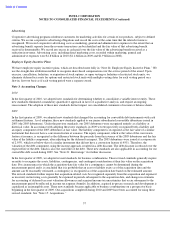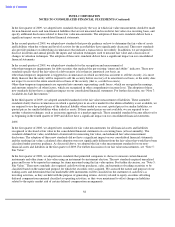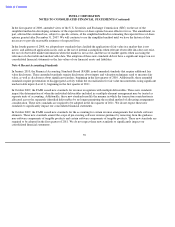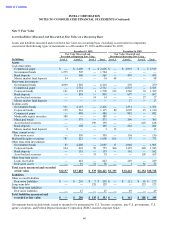Intel 2010 Annual Report Download - page 91
Download and view the complete annual report
Please find page 91 of the 2010 Intel annual report below. You can navigate through the pages in the report by either clicking on the pages listed below, or by using the keyword search tool below to find specific information within the annual report.
Table of Contents
INTEL CORPORATION
NOTES TO CONSOLIDATED FINANCIAL STATEMENTS (Continued)
In the preceding tables, the carrying value of our impaired non-marketable equity investments may not equal our fair value
measurement at the time of impairment due to the subsequent recognition of equity method adjustments, and the carrying
value of our impaired property, plant and equipment may not equal our fair value measurement at the time of impairment due
to the subsequent recognition of depreciation expense.
A portion of our non-marketable equity investments were measured and recorded at fair value due to events or circumstances
that significantly impacted the fair value of those investments, resulting in other-than-temporary impairment charges. We
classified these measurements as Level 3, as we used unobservable inputs to the valuation methodologies that were significant
to the fair value measurements, and the valuations required management judgment due to the absence of quoted market prices.
We determine the fair value of our non-marketable equity investments using the market and income approaches. The market
approach includes the use of financial metrics and ratios of comparable public companies. The selection of comparable
companies requires management judgment and is based on a number of factors, including comparable companies’ sizes,
growth rates, industries, development stages, and other relevant factors. The income approach includes the use of a discounted
cash flow model, which requires the following significant estimates for the investee: revenue, based on assumed market
segment size and assumed market segment share; costs; and discount rates based on the risk profile of comparable companies.
Estimates of market segment size, market segment share, and costs are developed by the investee and/or Intel using historical
data and available market data. The valuation of these non-marketable equity investments also takes into account variables
such as conditions reflected in the capital markets, recent financing activities by the investees, the investees’ capital structure,
and the terms of the investees’ issued interests.
During 2008, we recorded a $762 million impairment charge on our investment in Clearwire Communications, LLC
(Clearwire LLC) to write down our investment to its fair value, primarily due to the fair value being significantly lower than
the cost basis of our investment. The impairment charge was included in gains (losses) on equity method investments, net. We
determine the fair value of our investment in Clearwire LLC primarily using the quoted prices for its parent company,
Clearwire Corporation. The effects of adjusting the quoted price for premiums that we believe market participants would
consider for Clearwire LLC, such as tax benefits and voting rights associated with our investments, were mostly offset by the
effects of discounts to the fair value, such as those due to transfer restrictions, lack of liquidity, and differences in dividend
rights that are included in the value of Clearwire Corporation stock. We classified our investment in Clearwire LLC as Level
2, as the unobservable inputs to the valuation methodology were not significant to the measurement of fair value. For further
information about Clearwire LLC and Clearwire Corporation, see “Note 11: Equity Method and Cost Method Investments.”
We recorded a $250 million impairment charge on our investment in Numonyx during 2008 to write down our investment to
its fair value. Estimates for revenue, earnings, and future cash flows were revised lower due to a general decline in the NOR
flash memory market segment in 2008. We measured the fair value of our investment in Numonyx using a combination of the
income approach and the market approach. The income approach included the use of a weighted average of multiple
discounted cash flow scenarios of Numonyx, which required the use of unobservable inputs, including assumptions of
projected revenue, expenses, capital spending, and other costs, as well as a discount rate calculated based on the risk profile of
the flash memory market segment comparable to our investment in Numonyx. The market approach included the use of
financial metrics and ratios, such as multiples of revenue and earnings of comparable public companies. The impairment
charge was included in gains (losses) on equity method investments, net.
Additionally, certain of our property, plant and equipment was measured and recorded at fair value during 2010 and 2009 due
to events or circumstances we identified that indicated that the carrying value of the assets or the asset grouping was not
recoverable, resulting in impairment charges. Most of these asset impairments related to manufacturing assets.
Financial Instruments Not Recorded at Fair Value on a Recurring Basis
We measure the fair value of our non-marketable equity investments, marketable equity method investment, debt carried at
amortized cost, and cost method loans receivable quarterly for disclosure purposes; however, they are recorded at fair value
only if an impairment charge is recognized. The carrying amounts and fair values of financial instruments not recorded at fair
value on a recurring basis as of December 25, 2010 and December 26, 2009 were as follows:
64
2010
2009
Carrying
Fair
Carrying
Fair
(In Millions)
Amount
Value
Amount
Value
Non
-
marketable equity investments
$
2,633
$
5,144
$
3,411
$
5,723
Marketable equity method investments
$
31
$
167
$
—
$
—
Loans receivable
$
208
$
208
$
100
$
100
Long
-
term debt
$
1,949
$
2,283
$
2,083
$
2,314
























